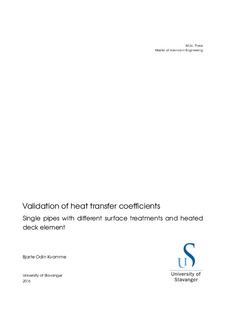| dc.contributor.advisor | Gudmestad, Ove Tobias | |
| dc.contributor.advisor | Hølland, Oddbjørn | |
| dc.contributor.author | Kvamme, Bjarte Odin | |
| dc.coverage.spatial | Arctic | nb_NO |
| dc.date.accessioned | 2016-09-28T12:29:55Z | |
| dc.date.available | 2016-09-28T12:29:55Z | |
| dc.date.issued | 2016-06 | |
| dc.identifier.uri | http://hdl.handle.net/11250/2411418 | |
| dc.description | Master's thesis in Offshore technology : Marine and subsea technology | nb_NO |
| dc.description.abstract | This master thesis has been written at the suggestion of GMC Maritime AS in agreement with the University of Stavanger.
The interest in the polar regions is increasing, and further research is required to evaluate the adequacy of the equipment and appliances used on vessels traversing in polar waters. The decrease in ice extent in the Arctic has renewed the interest in the Northern Sea Route. Oil and gas exploration has moved further north during the past decades, and tourism in the polar regions is becoming more popular. The introduction of the Polar Code by the International Maritime Organization attempts to mitigate some of the risks the vessels in Polar waters are exposed to.
This thesis investigates the adequacy of different theoretical methods of calculating the heat loss from cylinders and deck elements when exposed to a cross-wind scenario. Experiments were performed at GMC Maritime AS's climate laboratory on Buøy, Stavanger. The experiments were performed on 25 mm and 50 mm pipes with different surfaces, and on a deck element provided by GMC Maritime AS. Theoretical calculations are performed and compared with heat transfer coefficients calculated from experimental data. Measurements in real-life conditions were recorded aboard the KV Svalbard during a research project, SARex conducted off North Spitzbergen, April 2016. Statistics from this exercise are presented. Findings are compared with requirements in the Polar Code and industry recommended practices from DNV GL.
Correlations for convective heat transfer over cylinders are evaluated and compared. Based on the findings, the best correlation for use by the industry is selected and discussed. The arguments for selection were: Ease of use, Range of validity and Accuracy.
The correlation that was found to be best suited for single pipe configurations is the Churchill-Bernstein correlation. The deviation from the theoretical calculations to the experimental data for this correlation was found to be in the range of 0.40 % to 1.61 % for a 50 mm insulated pipe and -3.86 % to -2.79 % for a 25 mm insulated pipe, depending on wind speed.
For deck elements only one correlation for the average heat transfer coefficient for a flat plate is found in literature. This correlation is presented and used for theoretical calculations. The deviations from theoretical to experimental values was significant, and more work is required to verify the accuracy of the correlation for flat plates.
The estimated time to freeze for water in a pipe is calculated for a range of diameters with varying thicknesses of insulation at different wind speeds. Code for calculating the time to freeze is provided for further use by the reader. It is noted that to ensure the operation of pipe nozzles for fire extinguishing systems, these must also have heat tracing, but this topic is not discussed further in this thesis.
Key elements for an optimal design of deck elements are suggested. Experiences from testing in the laboratory and in the field are presented and discussed. | nb_NO |
| dc.description.sponsorship | GMC Maritime AS | nb_NO |
| dc.language.iso | eng | nb_NO |
| dc.publisher | University of Stavanger, Norway | nb_NO |
| dc.relation.ispartofseries | Masteroppgave/UIS-TN-IKM/2016; | |
| dc.rights | Navngivelse-DelPåSammeVilkår 3.0 Norge | * |
| dc.rights | Navngivelse-DelPåSammeVilkår 3.0 Norge | * |
| dc.rights.uri | http://creativecommons.org/licenses/by-sa/3.0/no/ | * |
| dc.subject | Polar Code | nb_NO |
| dc.subject | winterization | nb_NO |
| dc.subject | Arctic | nb_NO |
| dc.subject | Antarctic | nb_NO |
| dc.subject | polar waters | nb_NO |
| dc.subject | heat loss | nb_NO |
| dc.subject | heat transfer | nb_NO |
| dc.subject | heat transfer coefficient | nb_NO |
| dc.subject | convective heat transfer | nb_NO |
| dc.subject | heat transfer correlations | nb_NO |
| dc.subject | offshore teknologi | nb_NO |
| dc.subject | marin og undervannsteknologi | nb_NO |
| dc.title | Validation of heat transfer coefficients: Single pipes with different surface treatments and heated deck element | nb_NO |
| dc.type | Master thesis | nb_NO |
| dc.subject.nsi | VDP::Technology: 500::Marine technology: 580::Offshore technology: 581 | nb_NO |
| dc.source.pagenumber | 170 | nb_NO |

